Charging Instructions
Opening the Charge Port
The charge port is located on the left side of Model S, behind a door that is part of the rear tail light assembly. If your vehicle is equipped with two charge ports (an AC and a DC port), the ports are located behind a door on the left rear quarter panel in front of the rear tail light assembly. Park Model S to ensure that the charge cable easily reaches the charge port.
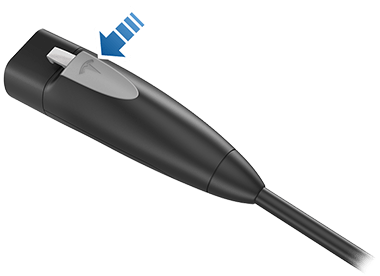
You can also open the charge port door using any of these methods:
- On the touchscreen, touch the Charge Port icon (lightning bolt).
- On the touchscreen, navigate to .
- Press the charge port door when Model S is unlocked and a recognized key is nearby (applies to Model S with one charge port only).
- On the key fob, hold down the rear trunk button for 1-2 seconds.
- Press the button on the charge cable to open the charge port door.
- Use voice commands to open the charge port door (see Voice Commands). You can also use voice commands to close the charge port door, and begin or stop charging.
Model S with one charge port:
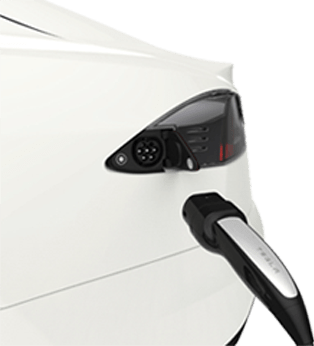
Model S with two charge ports:
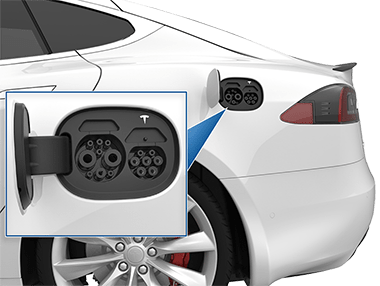
Plugging In
If desired, use the touchscreen to change the charge limit and the charging current (see Charge Settings).
To charge at a public charging station, plug the appropriate adapter into the vehicle's charging port, and then connect the station's charging connector to the adapter. The most commonly used adapter(s) for each market region are provided. Depending on the charging equipment you are using, you may need to start and stop charging using a control on the charging equipment.
If you are using the Mobile Connector, plug into the power outlet before plugging in Model S.
Align the connector to the charge port and insert fully. When the connector is properly inserted, charging begins automatically after Model S:
- Engages a latch that holds the connector in place;
- Shifts into Park (if it was in any other drive mode);
- Heats or cools the Battery, if needed. If the Battery requires heating or cooling, you may notice a delay before charging begins.
In some cases when Model S is plugged in but using very little energy, however, it may draw it directly from the Battery. For example, if you leave Model S plugged in for several days without using it, it may gradually draw a small amount of energy directly from the Battery to support vehicle systems.
Once the Battery discharges enough, it starts charging to reach the limit again. Depending on when you check, the Battery may not have discharged enough yet to trigger a charge cycle. As a result, it may be slightly under the charge limit even after being plugged in for a long period. This is normal, and Model S will start charging again once it has discharged enough. Alternatively, to start a new charge cycle manually, unplug and then plug in Model S.
Charge Port Light
After you insert a charge cable into Model S, wait a few seconds and confirm that the charge port light begins blinking green and that your vehicle is charging. If the light is amber or red, troubleshoot the issue before you leave to ensure a successful charging session.
- WHITE (OR LIGHT BLUE): The charge port door is open. Model S is ready to charge and the connector is not inserted, or the charge port latch is unlocked and the connector is ready to be removed.
- BLUE: The charger is connected, but Model S is not charging (such as when scheduled charging is active).
- BLINKING BLUE: Model S is communicating with the charger, but has not started charging yet (such as when your vehicle is preparing to charge).
- BLINKING GREEN: Charging is in progress. As Model S approaches a full charge, the frequency of the blinking slows.
- SOLID GREEN: Charging is complete.
- SOLID AMBER: The connector is not fully plugged in. Realign the connector to the charge port and insert fully.
- BLINKING AMBER: Model S is charging at a reduced current (AC charging only).
- RED: A fault is detected and charging has stopped. Check the instrument panel or touchscreen for an alert.
Charging Status
Charging status displays on the instrument panel when the charge port door is open.
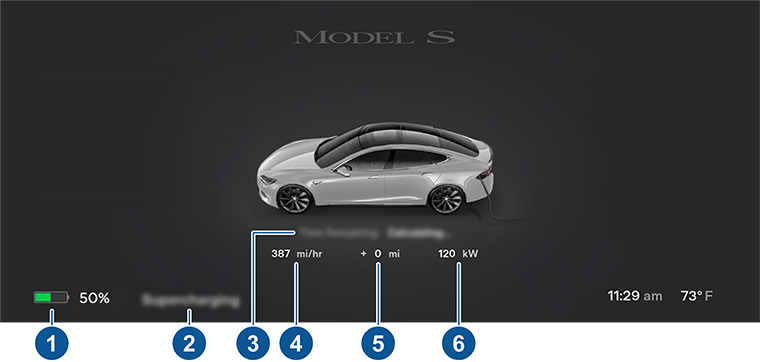
-
Driving distance: Displays the total estimated driving distance or energy percentage (depending on your display setting) available.NoteTo change how energy units are displayed, touch .
- Charge status: Charge status messages (such as Supercharging, Scheduled Charging) display here (see Scheduled Precondition and Charge).
-
Time remaining: The estimated time remaining to charge to your set limit (see Charge Settings). NoteWhen charging to 100%, the vehicle may continue to charge with low power when charging is displayed as complete. This is expected operation. Because the added energy beyond this point is low, it is usually not beneficial to continue charging.
- Charging rate: The current charging speed that the vehicle is charging.
- Range gained: Estimated increase in driving distance achieved in the charging session.
-
Charging: The current power of the charger.

If connected to a 3-phase power supply (if applicable in your region), the available current represents the current per phase and the 3-phase symbol displays.
During Charging
During charging, the charge port light (the Tesla "T" logo, in vehicles with two charge ports) pulses green, and the instrument panel displays real-time charging status. The frequency at which the green charge port light pulses slows down as the charge level approaches full. When charging is complete, the light stops pulsing and is solid green.
If the charge port light turns red while charging, a fault is detected. Check the instrument panel or touchscreen for an alert describing the fault. A fault can occur due to something as common as a power outage. If a power outage occurs, charging resumes automatically when power is restored.
Stopping Charging
Stop charging at any time by disconnecting the charge cable or touching Stop Charging on the touchscreen.
To disconnect the charge cable:
- Press and hold the button on the connector handle to release the latch.NoteYou can also release the latch using the touchscreen or mobile app, or by pressing and holding the rear trunk button on the key fob. If your vehicle is equipped with a motorized charge port, you can also press the button to the left of the charge port to release the latch.
- Pull the connector from the charge port.
If the charge cable gets frozen stuck while plugged in due to freezing temperatures, touch . This heats the charge port for up to two hours to unfreeze the charging cable.
- On the touchscreen, touch the Charge Port icon (lightning bolt) on the car status overview.
- On the touchscreen, navigate to .
- Use voice commands to close the charge port door (see Voice Commands).
- On the touchscreen, touch the Charge Port icon (lightning bolt) on the car status overview.
- On the touchscreen, navigate to .
- Use voice commands to close the charge port door (see Voice Commands).
Charge Settings
Access charge settings by touching when Model S is in Park. You can also touch the charge icon on the touchscreen to access charge settings.
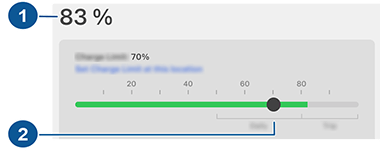
- Driving distance: Displays the total estimated driving distance available.
-
Set limit: Adjust the charge slider to the level of charging you want. The setting you choose applies to immediate and scheduled charging sessions.NoteTesla recommends limiting the Battery's full charge level to below 90% for Daily use and charging to 100% only if needed for a long Trip.NoteA portion of the battery image may appear blue. This indicates that a small portion of the energy stored in the battery is not available because the battery is cold. This is normal and no reason for concern. When the battery warms up, the blue portion no longer displays.
Slide the charge limit past the daily recommended charge limit for a pop-up option to temporarily charge above the daily recommended limit for one-time only. This is helpful for long trips and, if selected, resets back to the previous charge limit.
You can further adjust charge settings:
-
Charge current at this location: The current automatically sets to the maximum current available from the attached charge cable, unless it was previously reduced to a lower level. If needed, touch - or + to change the current (for example, you may want to reduce the current if you are concerned about overloading a domestic wiring circuit shared by other equipment). It is not possible to set the charging current to a level that exceeds the maximum available from the attached charge cable. When you change the current, Model S remembers the location. If you charge at
the same location, you do not need to change it again.
When charging using the Mobile Connector with domestic outlets, your vehicle may automatically select a default charge current. Override this default current to a higher setting by customizing Charge Current at this location or through the mobile app.
NoteFor 3-phase charging, the available current represents the current per phase (up to 32A). During charging, the right status flag displays the 3-phase symbol in front of the displayed current.NoteIf Model S is charging and detects unexpected fluctuations in input power, the charging current is automatically reduced by 25%. For example, a 16 amp current is reduced to 12 amps. This automatic current reduction increases robustness and safety in situations when an external problem exists (for example, a home wiring system, receptacle, adapter or cord is unable to meet its rated current capacity). As a precaution, when Model S automatically reduces current, it saves the reduced current at the charging location. Although you can manually increase it, Tesla recommends charging at the lower current until the underlying problem is resolved and the charging location can provide consistent power. - Open Charge Port, Unlock Charge Port and Stop Charging: When not charging, touch Open Charge Port or Unlock Charge Port to open the charge port door or to unlock the charge cable from the charge port. Use Stop Charging when you are finished charging.
- Schedule: Displays the precondition and charging schedule. You can create a precondition or charge schedule for your saved home and work locations, or your current location (see Scheduled Precondition and Charge).
- Supercharging: Displays Supercharger usage fees, the location, the time that charging started, and a cost estimate for the session (see Supercharger Fees).
Supercharger Fees
When charging at a Tesla Supercharger, information about the charging session displays at the bottom of the charging screen. This includes the location, the time that charging started, and a cost estimate for the session. When you stop Supercharging, the estimated cost of the session displays until a new Supercharging session begins. If free charging is applicable, the estimated cost displays as zero.
When charging at a Tesla supercharger, you are subject to idle fees. Idle fees are designed to encourage drivers to move their vehicle from the Supercharger when charging is complete. Idle fees are in effect only when half or more of the Superchargers at a site are occupied. The Tesla mobile app notifies you when charging is almost complete, and again when charging is complete. Additional notifications are sent if idle fees are incurred. Idle fees are waived if you move your vehicle within five minutes of when charging completed.
Log into your Tesla account to view fees and details about Supercharger sessions, track the remaining balance of free credits, set up a payment method, and make payments. Once a payment method is saved, fees are automatically paid from your account.
Manually Releasing Charge Cable
If the usual methods for releasing a charge cable from the charge port (using the charge handle release button, touchscreen, or mobile app) do not work, try pressing and holding down the rear trunk button on the key fob for 1-2 seconds. If it still doesn't release, carefully follow these steps:
- Ensure that Model S is not actively charging by displaying the charging screen on the touchscreen. If necessary, touch Stop Charging.
- Open the rear trunk.
- Open the flap on the left side of the trunk side trim.
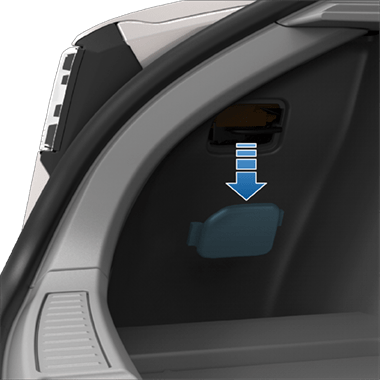
- Press and hold the charge port's manual release lever (highlighted in red in the image) toward the front of the vehicle to unlatch the charge cable.WarningDo not touch or attempt to remove the orange high voltage cover. Failure to follow these instructions can result in electric shock and serious injury.NoteIf your vehicle does not have a charge port manual release lever, discontinue this procedure and contact your nearest Service Center.NoteThe orientation of the manual release lever may vary depending on market region.

- Pull the charge cable from the charge port.
- Close the flap on the left side of the trunk side trim.
Charging Best Practices
- Avoid allowing the Battery to get too low (the Battery icon turns yellow when the capacity remaining in the Battery drops to 20% or below).
- Refer to the information on the vehicle touchscreen (navigate to ) or the mobile App (touch the Charging icon) for recommended daily and trip charging limits.
- After you plug in your vehicle, confirm that the charge port light begins blinking green (indicating that Model S is charging) before you walk away. If Model S does not begin charging after a few seconds, the connector may not be fully inserted into the charge port, or there may be an issue preventing charging. Check the touchscreen for an alert with more information.NoteIf the charge port light begins blinking amber, Model S is charging at a reduced current. If the charge port light is solid blue, the charger is connected but the vehicle is not charging (such as when a charge is scheduled). For more information, see Charge Port Light.
- Find fast chargers by filtering for three lightning bolts in the navigation search bar.
- Navigate to fast chargers to allow for preconditioning of the high voltage Battery. An optimal Battery temperature can help speed up charging.
- Typically, a lower state of charge results in faster charging.NoteIt is your responsibility to monitor your vehicle's charge at all times. Do not wait until the vehicle is discharged to plug it in. Always ensure you have more than enough charge to safely get to a charger.
- At Superchargers, leave some space between other vehicles, as neighboring stalls may share power.